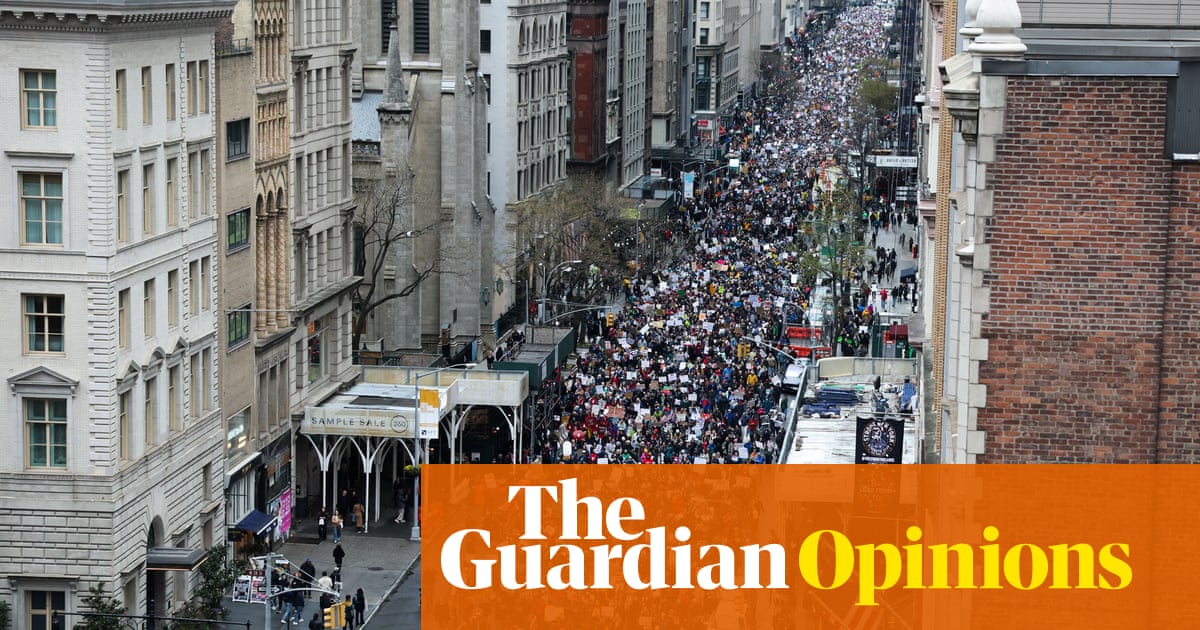Opinions about theproteststhismonthkeep oscillating between two extremes. Optimists point to the larger-than-expected numbers (larger than expected by many police departments for sure); theyenthusiastically recalla famous social scientificfindingaccording to which a non-violent mobilization of 3.5% of a population can bring down a regime. Pessimists, by contrast, see protests as largely performative. Both views are simplistic: it is true that protests almost never lead to immediate policy changes – yet they are crucial for building morale and long-term movement power.
Earlier this year, observers hadrushed to declareresistance “cringe” and a form of pointless “hyperpolitics”, a “vibe shift” (most felt by rightwing pundits, coincidentally) supposedly gaveDonald Trumpa clear mandate, even if he had won the election only narrowly. Meanwhile,Democratswere flailing in the face of a rapid succession of outrageous executive orders – many of which were effectively memos to underlings, rather than laws. But taken at face value, they reinforced an impression of irresistible Trumpist power.
As we now know from theCrowd Counting Consortium– a joint project by Harvard University and the University of Connecticut – this sense of defeatism was always more felt at elite level rather than on the ground: already in the first weeks of Trump 2.0, there werefar more proteststhan during the same period in the first administration. What seemed to be missing was a massive event serving as a focal point: now the more than 1,000 gatherings, with 100,000 showing up in DC alone, have provided one.
The enthusiasm about large and astonishingly diverse crowds has also revived a tendency, though, to focus on what has become an almost totemic number, a kind of social science Hallmark card for protesters: according toErica Chenoweth and Maria Stephan, civil, non-violent resistance that mobilizes 3.5% of a population has overwhelming chances of success (whereas violent action is actually more likely to fail or be outright counterproductive).
Three and a half per cent would mean 11 million people on the streets – even the Women’s March, generally seen as highly successful, mobilized “only” four or so million people. The first Earth Day event in 1970 – generally seen as the largest single-day demonstration in US history – brought out “only” 20 million.
As Chenoweth hascautioned, the 3.5% number was not some hard social scientific law, let alone a prescription. Many movements have been successful with fewer participants. Plus, what might best be described as a “historical tendency” was measured at a time when no one was conscious of it. Things might be different if one specifically tries to mobilize in light of a 3.5% goal; conversely, power-holders might now be determined to prevent resisters reaching a particular threshold at all costs.
In any case, protests and resistance are not the same: the former, by definition, accepts existing authorities and asks for change; the latter does not necessarily recognize the legitimacy of the powers that be – and it was the latter that Chenoweth and Stephan were looking at. Protest rarely leads to immediate policy change; in fact,according to the writer and activist LA Kauffman, perhaps the only clear example of a direct result is a protest that in fact did not happen. In 1941, the civil rights leader A Philip Randolph threatened Franklin D Roosevelt with a protest against racial discrimination in the defense industry and the military; before a march on Washington took place, Roosevelt conceded and issued anexecutive orderbanning discrimination in the defense industry.
Yet immediate policy change is not the only metric of success. Especially in light of the defeatist elite stance earlier this year, people coming out and seeing each other can be a major morale booster. What is so often dismissed as performative – music, drums, people parading with handmade signs to have their photos taken by others – is not a matter of collective narcissism; rather, it has been recognized by many modern thinkers, starting withRousseau, as an important part of building community. Politically inspired and inspiring festivals are not some frivolous sideshow; they allow citizens to experience each others’ presence, their emotional dispositions (many are seething withanger!), and their commitment.
Sign up toFighting Back
Big thinkers on what we can do to protect civil liberties and fundamental freedoms in a Trump presidency. From our opinion desk.
after newsletter promotion
True, it matters what happens next. Many of the protests that took place during the past decade wereultimately unsuccessfulbecause rapid mobilizationvia social mediahad not been preceded by patient organizing and the creation of effective structures for continuous engagement. By contrast, what remains the most famous protest in US history – the 1963 March on Washington – was a capstone march after years of difficult, often outright dangerous organizing. The march was flawlessly executed and produced celebrated images; it is less well-known that it was coordinated with the Kennedy administration and very tightly controlled by civil rights leaders (only approved signs were allowed; there wasan official recommendationfor what lunch to bring: peanut butter and jelly sandwiches).
At the end of the march, participants repeated a text read out by none other than A Philip Randolph: they promised they would not “relax until victory is won”. It matters whether those who expressed anger earlier this month can stay engaged, building on the easy connections during spontaneous encounters at a protest. Even by itself, though, what civil rights leaders called the “the meaning of our numbers” will be not go unnoticed by politicians and, less obviously, courts hardly insensitive to public opinion.
Jan-Werner Müller is a Guardian US columnist and a professor of politics at Princeton University
